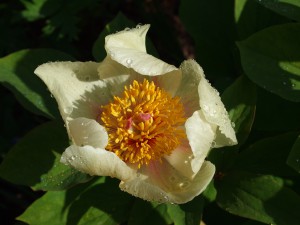March 2, 2015, by Editor
Cornelia de Moor’s blog for International Women’s Day
Small wonders
I have always seen the beauty in small living things, ever since I found a worm in the lawn in my first summer. Much of my childhood was spent finding feathers, daisies, tadpoles, mushrooms, berries and critters. My parents, although slightly mystified, encouraged my interests. They gave me a camera, which I mostly used to take close ups of flowers. With the gift of a toy microscope and later a more advanced model, the wonder of cells got to me. My father was a subscriber to Scientific American, in which I admired the pictures long before I understood the English language. I became an avid reader of natural history books, which I borrowed from the local library. In particlar, the Dutch translations of the “How and Why Wonder Books” captivated me.
Growth factors
It wasn’t immediately evident, though, that I was destined for an academic career. I found primary school boring and my marks were not very good. My father had to speak personally to the head of a secondary school in order to give me a chance to prepare for a university education. Eventually, I ended up studying Biology at Utrecht University and particularly enjoyed my research projects, examining the internal workings of human and frog cells (yes, those tadpoles again). This naturally led to doing a PhD at the Wilhelmina Children’s Hospital, in which I focussed on the properties of messenger RNAs that encode proteins regulating the growth of cells (and children).
Exciting ends
After my PhD in Utrecht, I worked in Massachusetts in the laboratory of Joel Richter, studying mRNAs in frog’s eggs. My work was increasingly focussed on the end of mRNAs, including the functions of the section behind the protein coding region and the final step in the synthesis of most mRNAs, polyadenylation. I co-discovered a regulatory mechanism that is now featured in textbooks (eg Lodish et al, Molecular Biology of the Cell, 7th edition, Fig 8-28). I vividly remember the first experiment that led to this discovery. I’d been injecting an RNA into the eggs to study its polyadenylation, when I noticed that one particular RNA appeared to speed up the maturation of the eggs in the presence of the maturation hormone. Wondering if the RNA could induce maturation on its own, I just injected the RNA and did not add hormone. It was late evening by the time the first eggs started maturing, and the only person I could find to share this momentous finding with, was a rather confused cleaner, who congratulated me nevertheless. It took several years and three papers to take that finding to the published mechanism, but I knew then we had something exciting.
Fungal forays
The wonder I found in small living things as a child still permeates my research career. My current work on the polyadenylation inhibitor cordycepin attracts public interest because it is isolated from a fascinating fungus that infects caterpillars. Cordycepin is helping us both understand more about fundamental mechanisms of gene expression as well as showing promise as a new type of medicine for cancer and inflammatory diseases. Excitingly, Arthritis Research UK recently awarded us with a grant to investigate the therapeutic potential of cordycepin. After all these years, I still like wandering about in natural places and I take pictures of flowers, fungi and insects during my holidays.
This spring, I’m indulging in a holiday in China to see the caterpillar fungi for myself as well as to see lots of other new little creatures…
Cornelia H. de Moor
Associate Professor in RNA Biology
School of Pharmacy, Nottingham





Very interesting, Cornelia.
I am not sure you will be “indulging in a holiday in China” this summer. Firstly we will be traveling in Eastern Tibet and secondly this is more of an adventure trip. When not poking around and looking for Yartsa gunbu, as Tibetans know Caterpillar fungus – Ophiocordyceps sinensis – in 4000m above treeline, and morels in subalpine forests around 3800m we will be traversing some really wild landscapes between 2900m and 4600m of altitude. In addition we will look for tons of wild flowers, including some wild relatives of the peony pictured above, perennial ones and hopefully tree peonies too. Can’t wait to start the journey.
I shoudl have added: Your profound research on Cordycepin is very important and I am happy to hear you will continue it.
By reading I understand more of the wonder of your research and what it entailed. the though of new drugs is great. With this we await to see how the drug comes along and how it will help millions of people.
Just think it all started with the wonder of tadpoles and frogs something of which you still love plus the wonders of all living things.